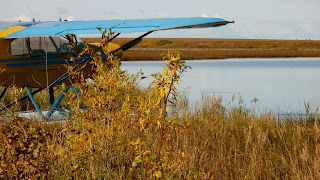I was able to fly into Bethel (and boat back) to attend a Mycology class offered by the Kuskokwim Community College (KCC). What a treat! I arrived late and a local educator at the college was sharing his presentation on ethno-botany in the region. The discussion I walked into was the use of 'punk,' a shelf fungus that is collected locally, dried, burned, and rolled up in a tobacco leaf. Highly addictive! I was offered some from an elderly lady when I was in Newtok. She had it under her bed in a #10 can. I tried it the one time, got very dizzy, and nauseous. The tobacco leaf unrolled and I spent the afternoon trying to get ashes out of my mouth.
The KCC campus is small, but houses a collection of local native craft. The baskets are made with coastal dune grass. These mostly came from the village of Kipnuk.
Several of the baskets had died seal intestines (dried and cut into thin strips) for the decorations. Others just had the died grass.
A variety of dolls are made in the region. These two were fabulous!
We met at the campus for a Friday night introduction as to what the weekend would look like. Dr. Gary Laursen came from Fairbanks at the University of Alaska. He travels the world at invitations from others to help in determining populations of fungi and lichen. He was to head off to the Faulkland Islands this winter.
We started at the sand pit (where I hear they play a mean game of golf in the fall...). We found mushroom after mushroom. Who would have thought there would have been so many?
Inky Cap family....They go quick! Shaggy Mane is a popular one. They "delequece", digest themselves, quickly. I learned that just kissing a fungi (or touching) is not what is poisonous, but it's the ingesting that causes the problems. He kept reassuring us that this was true!
We talked about a lot of different kinds of fungi, but mostly these four:
Agaric-those with gills (we mostly found these)
Boleto-those with spongy pores (underside)
PolyPore-the shelf fungi (found on the willow around here)
Puffballs-powdery sacs-six million spores with those puffs! (all up and down our airstrip for some reason)
We saw rusts, smuts and jellies too!
Oh my, a LBM (little brown mushroom)!
The lighter plant is a lichen, a combination of a fungi and algae. This picture also shows "tundra tea" the little tree looking plant, and low bush cranberries, the rounded green leaves.
Found out about the three roles that fungi play:
-parasitic-decomposer on something living
-saprophyte-decomposer on something dead
-micoryza-a living fungi on a root
With the alders here by the hospital, it was thought there would be a certain kind of mushroom. So, the caravan quickly pulled over.
Beautiful day to be out.
We found, in this little space six different kinds of mushroom, including the one they were looking for. Note I am not saying what kind.....it's because I can't remember....I just liked looking....
New location, off to the Black Spruce near Hanger Lake. Float planes come and go from this lake and a fairly recent story was a plane came in for a landing and overshot ending up in someone's backyard....hard to put the brakes on.
The spruce survive only because they have the fungi on their roots (mycorrhizae).
This is a Beaver. Had one of these lose its engine over Kasigluk. Heard it cut out and ran outside to see it soaring silently. Ran to where I thought it was going to crash only to see the pilot glide it onto the airstrip. There were some pretty grateful passengers.
I had no idea there were real evergreens out in these parts. There aren't many, in fact there is now one less. Someone came by and cut one down for a Christmas tree.
Making spore prints. Caps are removed, then all are covered by some kind of container. A small cup of water is to be placed inside. This moisture helps the bazillion spores release from the cap, scientifically speaking of course.
Collections mostly from the one day we were out. The Saturday was a collection day (a macro descriptive day). The Sunday became a microscope day (a micro descriptive day). We prepared slides and looked at a variety of spores.
Checking the spore prints. The tubs were lifted off the next morning. Spores were white, brown, fleshy pinkish, and black.
This fellow, Gary Laursen, is an extremely gifted educator. Watch out for him!































No comments:
Post a Comment